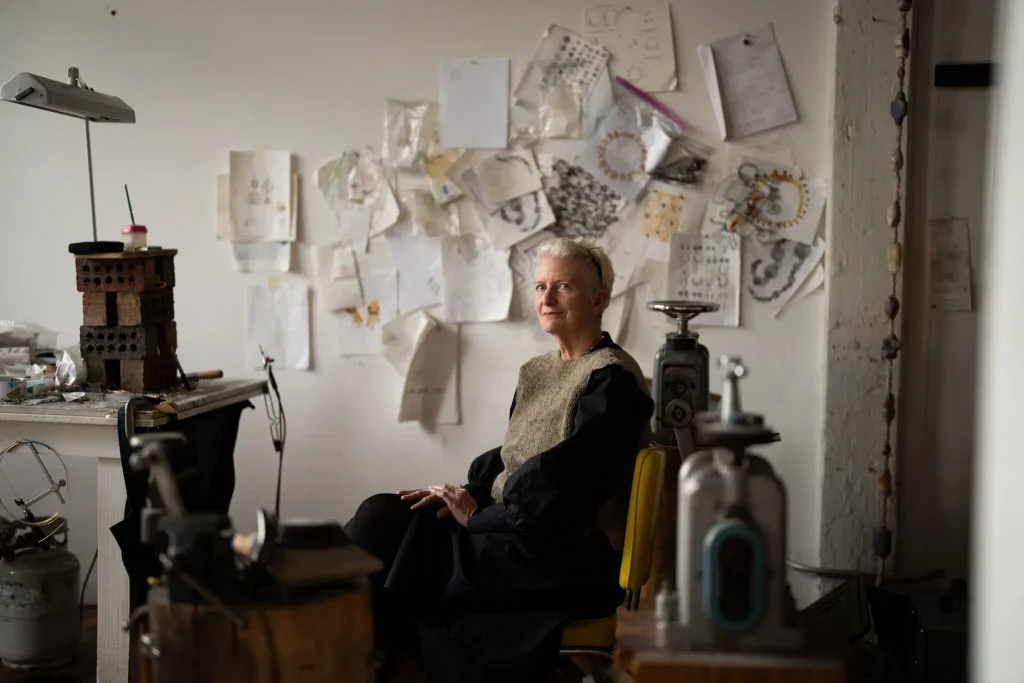Newsletter
Creating Jewelry by Hand Is Her Trademark
One of Judy Geib’s free-flowing designs, an 18-karat gold lace-like Peter Pan collar, was made with the scraps gathered from around her workbench. It is part of Studio Sweep, the series she began in 2018.
“I found so many beautiful little pieces of gold flowers, ferns and loops laying around,” the fine jewelry designer said in October during my visit to her studio in the Williamsburg section of Brooklyn. She had hammered and shaped the bits and pieces, assembling them into a series of large graphic collars and wide cuffs that were playful, architectural or a lyrical mishmash of shapes and textures.
That is typical of Ms. Geib’s creative process. Unlike most fine jewelers, she does not sketch or plan her designs, but rather she sits at her workbench seven days a week playing with metals, gems, wire and cardboard cutouts. “Hand making is especially important to me because it is a slow process that lets ideas gradually come into focus,” she said.


Ms. Geib, 65, has lent a personal touch to her craft over the past 25 years. She makes every piece from start to finish (a part-time assistant helps complete some) and crochets custom pouches for many. She’s even carved the wooden box for one special parure.
“Judy’s hand-touched aesthetic resonates with our clients,” said Andrew Mandell, a vice president and divisional merchandise manager at Bergdorf Goodman in New York, which has carried her jewelry for two years. One of the best examples, he said, is Ms. Geib’s rivière necklace of Colombian emeralds, each in a hand-forged 22-karat gold setting. “The shapes and patina aren’t exactly the same so it’s clear it’s done by hand.”
Her unconventional use of precious materials has also struck a chord with customers at the Gagosian Gallery’s Madison Avenue shop. “She brings a wide knowledge of art history, of architecture and of sculptural language to the table in a way that escapes more conservative approaches to jewelry design,” said Wyatt Allgeier, who works on the art gallery’s brand partnerships.


Committed to Craft
From an early age, Ms. Geib said, she was interested in making things. In 1981, she moved from Redding, Pa., to New York City to be an artist, working in painting, sculpture and graphic design.
In 1997, on a whim, she purchased two opals and made them into crude earrings. “Instantly, it felt right,” she said.
Learn More About Jewelry
- The Bigger, the Better: The outsize pieces often worn by hip-hop stars have influenced fine and high jewelry collections.
- A Family’s Vocation: All seven of Gregorio Cachi’s daughters followed him into making silver jewelry.
- The Power of the Horseshoe: Jewelry designers continue to use the talisman because, as one said, it has a “friendly vibe.”
- An Artist’s Eye: Elizabeth Gage turned her love of gold, gems and history into a decades-long career.
- More on Jewelry: Stories on trends and issues in the industry.
She read “Jewelry Making for Schools, Tradesmen, Craftsmen” by Murray Bovin, and started making jewelry. Five years later, in 2002, a friend introduced her to the buyers at Barneys New York, which sold her jewelry alongside its high fashion labels in its Manhattan flagship and seven other Barneys locations until its stores closed in 2020.
At that time, art jewelry was found most often at galleries and craft fairs, but Ms. Geib said that whatever she made, she brought to the store to sell.
Now her pieces are sold by several retailers in the United States; shops in Athens, London and Tokyo; and on a few online platforms. And while they are priced across a wide range, most are $3,000 to $15,000. “I never figure out the price of a project until I finish it,” she said. “So, the idea of cost never constrains me.”




Eclectic Influences
Her designs have been inspired by a range of eclectic sources, including literature and African textiles. After reading “Moby Dick,” she said, “I was in such awe that I just wanted to make homages to the beautiful and playful masterpiece.” That resulted in a 2017 series of gold and silver jewelry depicting waves and whales.
Calligraphy has influenced several series. “I’m charmed by the thick and thin swoops,” she said, “and I love achieving that effect by what I call ‘askew hammering.’” A favorite book on African textiles filtered into her work through a cuff made with large and small gold loops, which reminded her “of an African batik of lots of circles with holes in them, closely packed together.”
Ms. Geib’s sprawling studio, where she has worked for 15 years, is cluttered with books, textiles and weaving materials. There are scores of tools and bits of jewelry around her workbench, as well as trays of gemstones, piles of curlicue-shaped silver and gold strands, and works of jewelry in progress.
She is constantly adding to her collection of gemstones. On her first visit to the Tucson gem and jewelry shows 25 years ago, she met a Colombian emerald dealer and has been using gems from Colombia ever since. For the past several years she has traveled to Bogotá, the Colombian capital, to visit the Emerald Trade Center, where she can buy stones from gem cutters who have purchased them from miners around the country.
“I choose stones for their color and beauty,” she said. “The deep green emeralds are the most valuable, but I tend to like the brighter, light-colored emeralds.”


An Irreverent Approach
Even though she may be working with the precious stones, she takes an irreverent approach to design. “I like to be reckless and playful with the fancy stones,” she said, holding up a necklace of emeralds in a bold and chunky floral setting of oxidized silver.
The design, she said, was inspired by Berlin iron jewelry, which was made with cast iron in early 19th-century Prussia when people were asked to donate their gold to fund the battle against Napoleon. “There’s a crudeness to this setting,” she said. “It’s dark, it feels a little rough and heavy, and the contrast makes the emeralds pop.”
She also seeks out unusual stones, like dendritic agate, which comes in many colors and patterns, and can look like paintings of natural landscapes. She buys them from a dealer whose family mines land in the central Indian region of Madhya Pradesh, whom she has worked with for years.
And she works with rubies, opals, quartz and sapphires. Her recent Kaleidoscope earrings, for instance, combined rose quartz, peridot, orange and pink sapphires and moonstones in a variety of shapes and sizes into an openwork design.
Perhaps her most signature pieces are the flattened, or what she calls squashed, gold flowers and shapes presented as earrings, necklaces and bracelets.
Ms. Geib’s creativity isn’t limited to jewelry though, as she sews many of her own garments. “Sometimes it’s easier to make something than go shopping for it,” she said.
Her peers have called her a jeweler’s jeweler: “Judy is so inspiring to other makers because she is a real artist whose process is very personal and experimental and genuinely unique,” said David Rees, co-founder of the fine jewelry brand TenThousandThings in New York.
“It’s very special to find someone with such an original vision who follows her own inspirations no matter where that might take her.”

